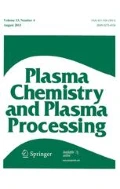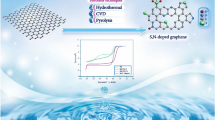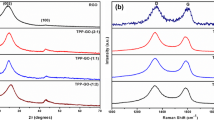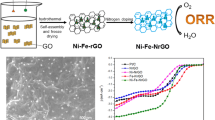Abstract
A batch process is developed to generate sulphur functionalized graphene nanoflakes (S-GNFs), corresponding to nanoparticles of stacked graphene. The growth and functionalization of the catalysts are done in a single thermal plasma reactor. The GNFs are first grown through the decomposition of methane in the thermal plasma volume followed by homogeneous nucleation of the nanoparticles in the well-controlled recombining plasma stream allowing the 2-dimensional evolution of the nanoparticle morphology. The precursor feeding conditions are then changed to liquid carbon disulphide in order to generate sulphur-based functional groups on the nanoparticles. The plasma conditions and carbon disulphide injection are varied, and samples with tuneable amount of sulphur between 4 and 28 at% are obtained. The functional groups generated include polythiophene polymer partly covering the GNFs, sulphur functionalities implemented directly on the graphitic structure, and traces of orthorhombic sulphur. The S-GNFs exhibit higher electrocatalytic activity toward the oxygen reduction reaction in alkaline medium for the samples containing the highest amounts of sulphur.







Similar content being viewed by others
References
McLean G (2002) An assessment of alkaline fuel cell technology. Int J Hydrogen Energy 27:507–526. doi:10.1016/S0360-3199(01)00181-1
Song C, Zhang J (2008) Electrocatalytic oxygen reduction reaction. PEM Fuel Cell Electrocatal Catal Layers. doi:10.1007/978-1-84800-936-3_2
Mukerjee S, Srinivasan S (1993) Enhanced electrocatalysis of oxygen reduction on platinum alloys in proton exchange membrane fuel cells. J Electroanal Chem 357:201–224. doi:10.1016/0022-0728(93)80380-Z
Greeley J, Stephens IEL, Bondarenko AS et al (2009) Alloys of platinum and early transition metals as oxygen reduction electrocatalysts. Nat Chem 1:552–556. doi:10.1038/nchem.367
Zhang X, Ouyang W, Zeng D et al (2015) Nitrogen doped sublimed carbon as non-noble metal catalyst for oxygen reduction reaction. Catal Today. doi:10.1016/j.cattod.2015.07.009
Niu K, Yang B, Cui J et al (2013) Graphene-based non-noble-metal Co/N/C catalyst for oxygen reduction reaction in alkaline solution. J Power Sources 243:65–71. doi:10.1016/j.jpowsour.2013.06.007
Bezerra CWB, Zhang L, Lee K et al (2008) A review of Fe-N/C and Co-N/C catalysts for the oxygen reduction reaction. Electrochim Acta 53:4937–4951. doi:10.1016/j.electacta.2008.02.012
Wu Z, Yang S, Sun Y et al (2012) 3D nitrogen-doped graphene aerogel-supported Fe3O4 nanoparticles as efficient electrocatalysts for the oxygen reduction reaction. J Am Chem Soc 134:9082–9085. doi:10.1021/ja3030565
Razmjooei F, Singh KP, Song MY, Yu JS (2014) Enhanced electrocatalytic activity due to additional phosphorous doping in nitrogen and sulfur-doped graphene: a comprehensive study. Carbon N Y 78:257–267. doi:10.1016/j.carbon.2014.07.002
Olivella MA, Palacios JM, Vairavamurthy A et al (2002) A study of sulfur functionalities in fossil fuels using destructive- (ASTM and Py-GC-MS) and non-destructive- (SEM-EDX, XANES and XPS) techniques. Fuel 81:405–411. doi:10.1016/S0016-2361(01)00198-3
Sheng Z-H, Gao H-L, Bao W-J et al (2012) Synthesis of boron doped graphene for oxygen reduction reaction in fuel cells. J Mater Chem 22:390–395. doi:10.1039/C1JM14694G
Yang Z, Yao Z, Li G et al (2012) Sulfur-doped graphene as an efficient metal-free cathode catalyst for oxygen reduction. ACS Nano 6:205–211. doi:10.1021/nn203393d
Zhang L, Niu J, Li M, Xia Z (2014) Catalytic mechanisms of sulfur-doped graphene as efficient oxygen reduction reaction catalysts for fuel cells. J Phys Chem C 118:3545–3553. doi:10.1021/jp410501u
Park J, Jang YJ, Kim YJ et al (2013) Sulfur-doped graphene as a potential alternative metal-free electrocatalyst and Pt-catalyst supporting material for oxygen reduction reaction. Phys Chem Chem Phys 16:103–109. doi:10.1039/c3cp54311k
Yang S, Zhi L, Tang K et al (2012) Efficient synthesis of heteroatom (N or S)-doped graphene based on ultrathin graphene oxide-porous silica sheets for oxygen reduction reactions. Adv Funct Mater 22:3634–3640. doi:10.1002/adfm.201200186
Pristavita R, Meunier JL, Berk D (2011) Carbon nano-flakes produced by an inductively coupled thermal plasma system for catalyst applications. Plasma Chem Plasma Process 31:393–403. doi:10.1007/s11090-011-9289-0
Pristavita R, Mendoza-Gonzalez NY, Meunier JL, Berk D (2010) Carbon blacks produced by thermal plasma: the influence of the reactor geometry on the product morphology. Plasma Chem Plasma Process 30:267–279. doi:10.1007/s11090-010-9218-7
Meunier JL, Mendoza-Gonzalez NY, Pristavita R et al (2014) Two-dimensional geometry control of graphene nanoflakes produced by thermal plasma for catalyst applications. Plasma Chem Plasma Process. doi:10.1007/s11090-014-9524-6
Legrand U, Mendoza Gonzalez NY, Pascone P et al (2016) Synthesis and in situ oxygen functionalization of deposited graphene nanoflakes for nanofluid generation. Carbon N Y 102:216–223
Pascone P-A, de Campos J, Meunier J-L, Berk D (2016) Iron incorporation on graphene nanoflakes for the synthesis of a non-noble metal fuel cell catalyst. Appl Catal B Environ 193:9–15. doi:10.1016/j.apcatb.2016.04.002
Pascone P-A, Berk D, Meunier J-L (2013) A stable and active iron catalyst supported on graphene nano-flakes for the oxygen reduction reaction in polymer electrolyte membrane fuel cells. Catal Today 211:162–167. doi:10.1016/j.cattod.2013.03.026
Schmid M, Steinrück HP, Gottfried JM (2014) A new asymmetric Pseudo-Voigt function for more efficient fitting of XPS lines. Surf Interface Anal 46:505–511. doi:10.1002/sia.5521
Bokobza L, Bruneel J-L, Couzi M (2015) Raman spectra of carbon-based materials (from graphite to carbon black) and of some silicone composites. C J Carbon Res 1:77–94. doi:10.3390/c1010077
Wu G, Johnston CM, Mack NH et al (2011) Synthesis-structure-performance correlation for polyaniline-Me-C non-precious metal cathode catalysts for oxygen reduction in fuel cells. J Mater Chem 21:11392–11405. doi:10.1039/c0jm03613g
Harvey PD, Butler IS (1986) Raman spectra of orthorhombic sulfur at 40 K. J Raman Spectrosc 17:329–334. doi:10.1002/jrs.1250170407
Larouche N, Stansfield BL (2010) Classifying nanostructured carbons using graphitic indices derived from Raman spectra. Carbon N Y 48:620–629. doi:10.1016/j.carbon.2009.10.002
Downs B, Robinson S, Yang H, Mooney P. RRUFF. http://rruff.info/Sulfur/R050006
Zhang Y, Han T, Fang J et al (2014) Integrated Pt2Ni alloy@Pt core-shell nanoarchitectures with high electrocatalytic activity for oxygen reduction reaction. J Mater Chem A 2:11400–11407. doi:10.1039/C4TA00731J
Tanaka K, Yoshizawa K, Takeuchi T, Yamauchi JUN (1990) Plasma polymerization of thiophene and 3-methylthiophene. Synthetic Met 38:107–116
Zhou Y, Candelaria SL, Liu Q et al (2014) Sulfur-rich carbon cryogels for supercapacitors with improved conductivity and wettability. J Mater Chem A 2:8472. doi:10.1039/c4ta00894d
Li C, Shi G (2013) Polythiophene-based optical sensors for small molecules. ACS Appl Mater Interfaces 5:4503–4510. doi:10.1021/am400009d
Acknowledgements
We acknowledge Pierre Pascone for the Raman spectroscopy, Dr. Lihong Shang for the XRD measurements, and Dr Cornelia Chilian for the NAA. We also acknowledge the funding contributions from McGill Engineering Doctoral Award (MEDA), the Fonds de Recherche Nature et Technologie du Quebec (FRNTQ) and from Natural Science and Engineering Research Council (NSERC) of Canada.
Author information
Authors and Affiliations
Corresponding author
Rights and permissions
About this article
Cite this article
Legrand, U., Meunier, JL. & Berk, D. Addition of Sulphur to Graphene Nanoflakes Using Thermal Plasma for Oxygen Reduction Reaction in Alkaline Medium. Plasma Chem Plasma Process 37, 841–856 (2017). https://doi.org/10.1007/s11090-017-9787-9
Received:
Accepted:
Published:
Issue Date:
DOI: https://doi.org/10.1007/s11090-017-9787-9




